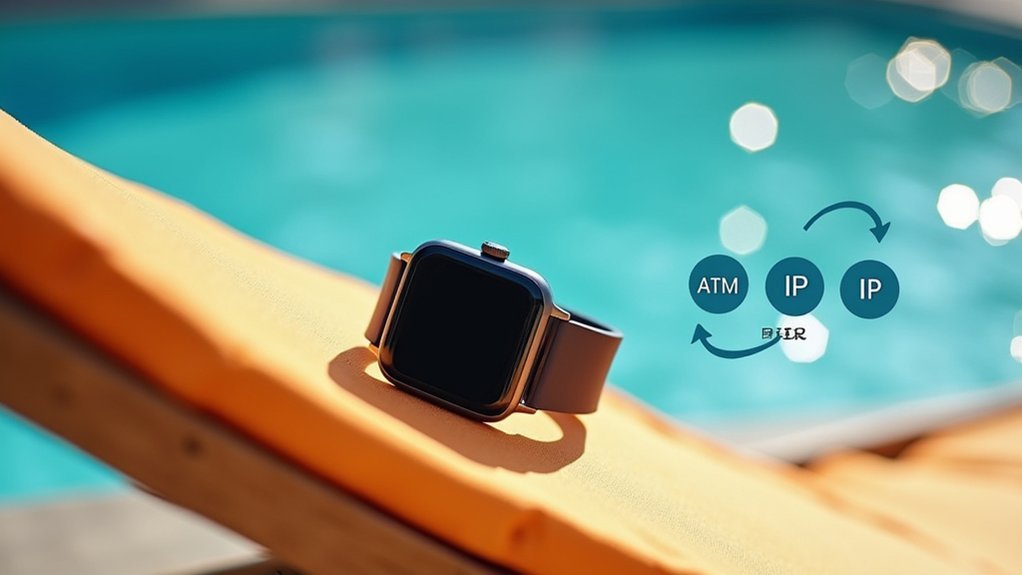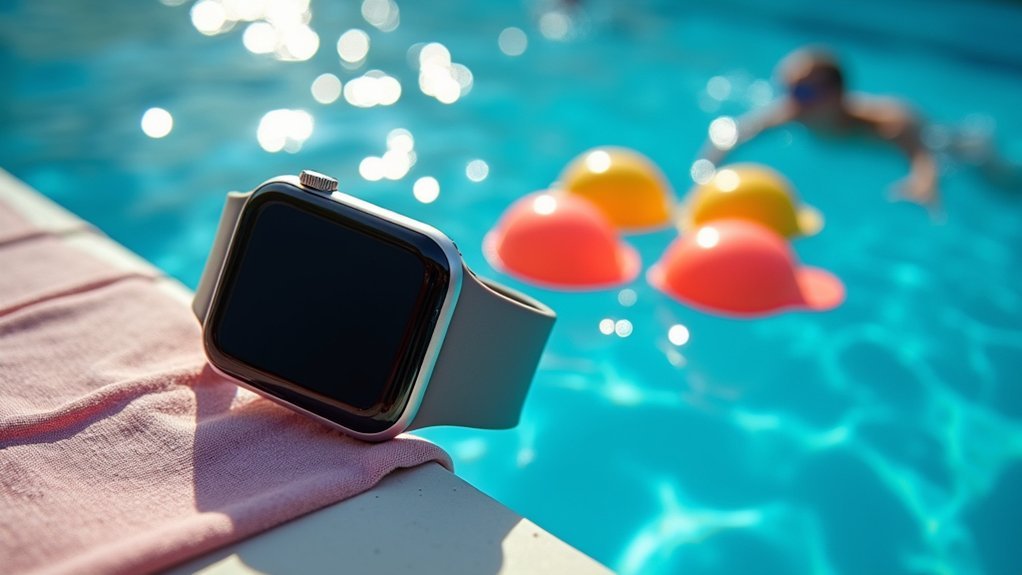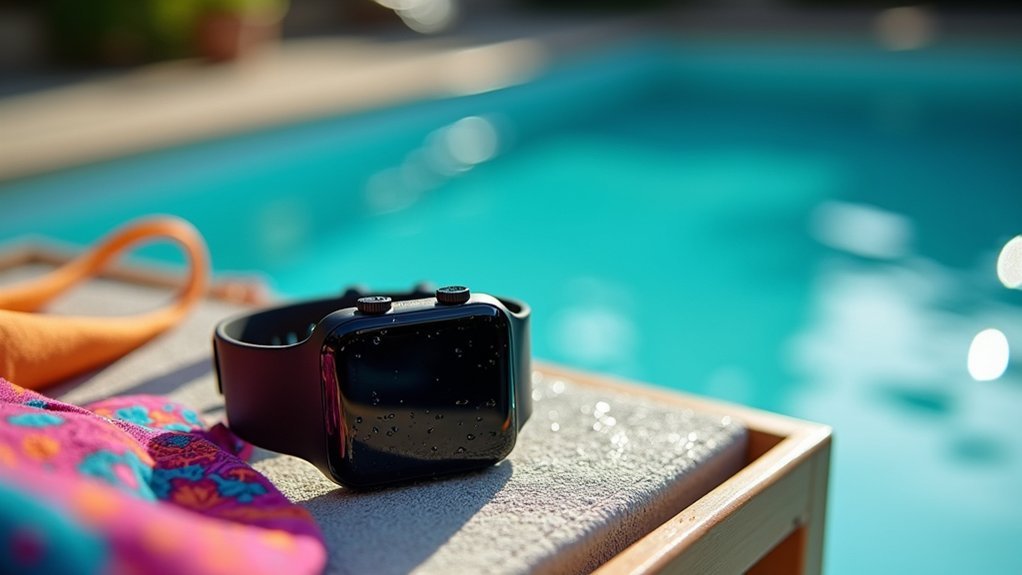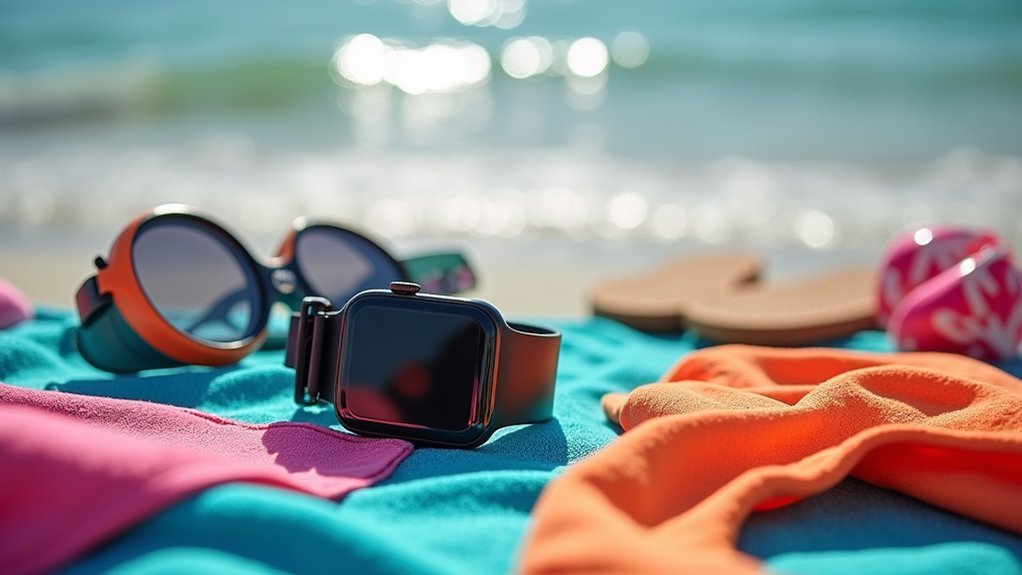You’ll need a minimum 5 ATM water resistance rating for swim wearables to handle dynamic water pressure during swimming activities. While IP68 ratings protect against splashes and brief submersion, they’re insufficient for serious aquatic sports since they only test static conditions up to 1.5 meters depth. The 5 ATM standard equates to 50 meters of static pressure resistance, making it suitable for lap swimming and shallow water sports. Understanding these rating differences will help you choose the right device for your aquatic adventures.
Understanding ATM Vs IP Water Resistance Ratings

When you’re shopping for swim wearables, you’ll encounter two primary water resistance rating systems that aren’t interchangeable: ATM (atmospheres) and IP (Ingress Protection).
ATM measures static water pressure resistance, with each ATM equaling roughly 10 meters of water depth. This system’s designed specifically for underwater activities, making 5 ATM the standard for swim-ready wearables.
5 ATM rating equals 50 meters of static water pressure resistance, establishing the baseline for truly swim-capable wearable devices.
IP ratings focus on dust and water ingress protection over time at shallow depths. Common ratings like IPX7 and IPX8 test a device’s ability to resist water entry during brief submersion, but they’re not pressure-based. Devices must also pass tests for thermal shock to ensure water resistance remains effective across temperature changes.
While IP ratings work well for everyday splashes and rain protection, they don’t account for the dynamic water pressure you’ll experience during swimming strokes, making them inadequate for serious aquatic activities.
The 5 ATM Standard for Swimming Activities
The 5 ATM rating represents your device’s ability to withstand pressure equivalent to 50 meters of water depth, but this number creates more confusion than clarity for swimmers.
Laboratory testing uses static pressure conditions that don’t reflect real swimming scenarios where arm movements and water turbulence create dynamic pressure spikes.
Here’s what you need to know about 5 ATM devices for swimming:
- Safe for surface activities – Hand washing, rain exposure, and showering are generally fine
- Risky for actual swimming – Dynamic water pressure from stroke movements exceeds static test conditions
- Temperature matters – Rating assumes 25-30°C water, not varying pool or ocean temperatures
- Seal degradation occurs – Water resistance decreases over time, making swimming even riskier
Remember that these devices are water-resistant, not completely waterproof, which means they have inherent limitations.
You’re better off choosing higher-rated devices for regular swimming activities.
Why IP68 Falls Short for Water Sports

While IP68 sounds impressive, you’ll quickly discover its limitations when you’re actually swimming or participating in water sports.
The standard only guarantees protection at shallow depths of 1.5 meters under static conditions, which doesn’t match real swimming scenarios where you’re moving through water at varying depths.
You’ll face dynamic pressure changes that IP68 testing simply doesn’t account for, leaving your device vulnerable when water pressure fluctuates during active use. Unlike IP69 devices that resist high-pressure water jets, IP68-rated swim wearables lack the reinforced protection needed for the turbulent water conditions you encounter during vigorous swimming strokes.
Depth Limitations Explained
Although IP68 ratings provide solid water resistance for everyday scenarios, they’re not engineered to handle the demanding conditions of serious water sports.
You’ll find that these devices typically max out at 1.5 meters depth—roughly 5 feet—which isn’t sufficient for most aquatic activities beyond casual pool swimming.
Here’s what you need to know about IP68 depth limitations:
- 30-minute time limit – Exceeding this duration underwater can cause water ingress
- Pressure vulnerability – Water pressure increases considerably with depth, overwhelming device seals
- Shallow water only – Perfect for pool activities but inadequate for open water swimming
- No diving protection – Completely unsuitable for scuba diving or deep-water sports
For serious water activities, you’ll need devices specifically rated for higher pressures and greater depths. Additionally, exposure to saltwater creates corrosive effects that can compromise even IP68-rated devices over time.
Dynamic Pressure Problems
Beyond static depth concerns, IP68-rated devices face even greater challenges when you expose them to dynamic water pressure changes. When you’re swimming, diving, or engaging in water sports, rapid depth changes create pressure fluctuations that IP68 wasn’t designed to handle.
| Challenge | Impact on IP68 Devices |
|---|---|
| Pressure Fluctuations | Seals compromise under rapid changes |
| Saltwater Exposure | Accelerated corrosion of protective seals |
| Repeated Immersion | Gradual degradation of water resistance |
| Mechanical Stress | Electronic components suffer damage |
| Depth Variations | Manufacturer specs don’t cover dynamic scenarios |
Your device’s seals deteriorate with each pressure cycle, and saltwater accelerates this degradation. The mechanical stress from pressure changes can damage internal electronics, while manufacturer specifications rarely account for these dynamic conditions you’ll encounter during active water sports. Many users make the mistake of pressing buttons underwater, which can compromise the device’s protective barriers and allow water ingress even within the rated depth limits.
Static Vs Dynamic Water Pressure in Real-World Swimming
When you’re testing your swim wearable in a controlled environment, manufacturers typically measure static pressure—the steady force water exerts at specific depths.
However, you’ll encounter dynamic pressure during actual swimming, where water moves against your device as you stroke, kick, and navigate through currents.
This fundamental difference means your device’s lab-tested water resistance rating doesn’t account for the additional stress created by your movement through water. The sealing material can deteriorate over time, further reducing your device’s ability to withstand these real-world swimming conditions.
Static Pressure Testing Limitations
While your swim wearable might boast impressive water resistance ratings like 5ATM or 50 meters, these certifications don’t tell the whole story about real-world swimming performance.
These ratings come from static pressure tests that simulate constant water force at set depths under controlled lab conditions.
Here’s what static pressure testing actually misses:
- Dynamic movement stress – Your arm strokes, turns, and body movements create fluctuating pressures that static tests can’t replicate.
- Button functionality underwater – Pressing buttons while submerged can compromise seals that only passed static testing.
- Repeated immersion effects – Multiple swim sessions stress components beyond what short-duration lab tests evaluate.
- Real-world turbulence – Pool currents and open water conditions generate forces that uniform static pressure doesn’t account for.
Your device might pass certification but still fail during actual swimming. Understanding that ATM ratings measure static pressure equivalent to water depth helps explain why real swimming conditions can overwhelm these laboratory-based measurements.
Dynamic Movement Affects Resistance
The physics of swimming fundamentally changes how water pressure affects your wearable device. Unlike static water pressure that remains constant at a given depth, dynamic pressure fluctuates dramatically with your swimming speed and movements.
When you’re swimming front crawl at 2 m/s, the dynamic pressure calculated as q = 0.5 × ρ × v² creates substantially higher forces than static conditions alone.
Your stroke mechanics generate pressure spikes that can reach 50 N on your hands during powerful propulsive phases. These forces aren’t steady—they’re constantly changing as you accelerate, decelerate, and change direction.
Your wearable experiences pushing and pulling forces that align with your propulsion mechanics, creating a complex pressure environment that static ratings simply can’t predict or account for accurately. The propulsive force variations occur with such frequency that testing must account for the kinematic patterns of real swimming performance.
Key Testing Standards: ISO 22810:2010 and IEC 60529:2013

Understanding water resistance ratings for swim wearables requires familiarity with two critical testing standards that govern how manufacturers evaluate and certify their devices. These standards determine whether your wearable can withstand aquatic pressures.
Water resistance ratings depend on precise testing standards that determine if your device can handle real swimming conditions.
ISO 22810:2010 specifically targets swim wearables, testing devices under pressure conditions that simulate actual swimming depths. It uses ATM ratings (3 ATM for 30 meters, 5 ATM for 50 meters) and includes thermal shock testing to guarantee seals remain watertight under temperature variations. Manufacturers recommend annual testing by authorized service facilities to maintain water resistance integrity over time.
IEC 60529:2013 defines IP ratings focused on environmental protection against dust and water jets, but doesn’t account for water pressure during swimming.
Key differences include:
- ISO 22810 tests dynamic pressure exposure during swimming
- IP ratings only test static water immersion
- ATM ratings specify depth equivalences for aquatic activities
- ISO certification guarantees suitability for prolonged underwater use
Design Challenges for Waterproof Swim Wearables
Despite meeting ISO 22810:2010 certification requirements, swim wearable manufacturers face significant engineering obstacles that extend far beyond basic waterproofing.
You’ll find material selection essential, as designers must balance durability with comfort while incorporating innovative fabrics like Fastskin that reduce drag.
Manufacturing processes demand precision sealing and specialized equipment to prevent water ingress consistently.
Sensor technology presents ongoing challenges since water interferes with optical signals, disrupting PPG sensors in smartwatches.
Movement artifacts from swimming strokes further distort data collection, requiring advanced algorithms for accuracy.
Power management becomes vital as you need extended battery life during long sessions while protecting components from water exposure. Devices like FINIS SwimSense demonstrate how wearable tech can successfully provide metrics such as lap count, distance, and calories burned while maintaining waterproof integrity.
Integration systems must overcome signal interference to provide real-time feedback and meaningful performance metrics.
Choosing the Right Rating for Different Water Activities

Once manufacturers overcome these engineering hurdles, you’ll need to match your device’s water pressure rating with your specific aquatic activities.
Your wearable’s rating determines which activities it can safely handle without compromising functionality or warranty coverage.
Understanding your device’s water resistance rating ensures you can enjoy aquatic adventures without voiding your warranty or damaging expensive electronics.
Here’s how to choose the right rating:
- 3 ATM (30m) – Perfect for daily wear, light rain, and hand washing, but skip swimming entirely.
- 5 ATM (50m) – Ideal for lap swimming, pool activities, and shallow water sports like the Samsung Gear Sport.
- 10 ATM (100m) – Handles intense activities including snorkeling, surfing, and open water swimming with thermal shock resistance.
- Avoid high-temperature environments – Saunas, hot showers, and chemical exposure damage any rating level.
Remember that water resistance performance may decline over time due to normal wear and regular use of your device.
How Water Resistance Impacts Performance and Durability
Your swim wearable’s water resistance rating directly affects how well it performs during aquatic activities and how long it’ll last under repeated water exposure. Higher-rated devices maintain fitness tracking accuracy when water can’t penetrate sensors or electronics.
However, you’ll notice touchscreen responsiveness often decreases when wet, affecting usability during swimming. Water resistance features protect critical seals and gaskets from corrosion, extending your device’s lifespan.
Without proper protection, moisture damage becomes inevitable. Saltwater and chlorine pose greater threats than freshwater, accelerating component wear through chemical reactions.
You should expect sustained water exposure to stress materials, especially when temperature fluctuations cause expansion and contraction. Proper water resistance reduces these failures, but you’ll need regular maintenance every two years to guarantee ongoing protection and peak performance. Remember that water resistance ratings are tested under static pressure conditions, which means the actual pressure your device experiences during active swimming or diving will be significantly higher.
Frequently Asked Questions
Can I Wear My 3 ATM Smartwatch in the Shower?
You shouldn’t wear your 3 ATM smartwatch in the shower. Hot water and pressure can damage seals, reducing water resistance. Manufacturers recommend avoiding showers to prevent long-term damage to your device.
Do Water Resistance Ratings Decrease Over Time With Regular Use?
Yes, your water resistance ratings decrease over time. Regular use degrades seals and gaskets naturally. Temperature changes, impacts, and chemical exposure accelerate this process. You’ll need periodic maintenance to restore original protection levels.
What Happens if Saltwater Gets Inside My Swim Wearable?
Saltwater will corrode your device’s metal components, cause short circuits, and create salt buildup that damages sensors. You’ll likely face permanent malfunction, voided warranty, and expensive repairs if saltwater penetrates inside.
Are There Any Swim Wearables With Ratings Higher Than 10 ATM?
You won’t find consumer swim wearables rated above 10 ATM. Standard fitness trackers and smartwatches max out around 5-10 ATM, focusing on swimming features rather than extreme water resistance for recreational use.
How Much Does Water Resistance Certification Affect the Device Price?
Water resistance certification considerably impacts your device’s price. You’ll pay more for higher ratings like 5 ATM due to advanced materials, rigorous testing, and specialized sealing techniques that increase manufacturing costs substantially.
In Summary
You’ll need at least 5 ATM water resistance for swimming wearables, as IP68 ratings don’t account for dynamic water pressure during actual swimming movements. Don’t settle for basic splash-proof ratings if you’re serious about water sports. Consider your specific activities – casual pool swimming requires different protection than competitive swimming or diving. Remember that water resistance degrades over time, so you’ll want higher ratings for long-term durability and reliable performance in aquatic environments.





Leave a Reply